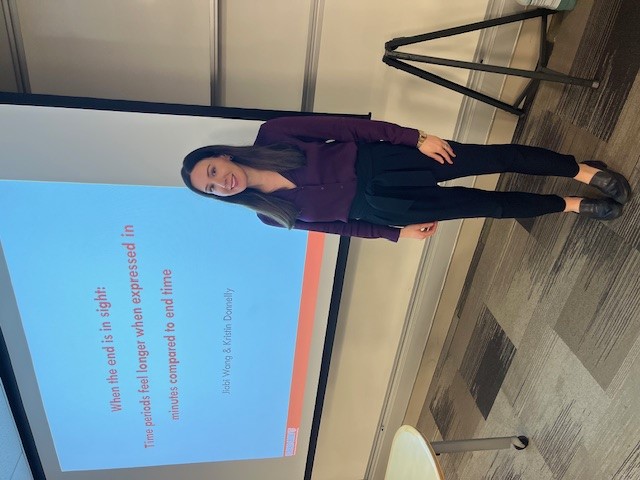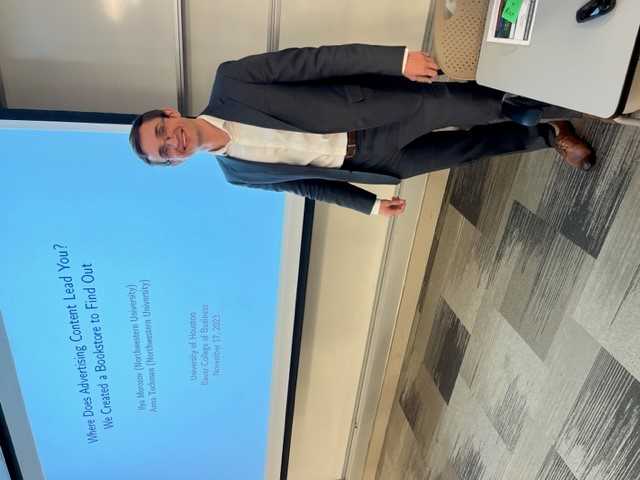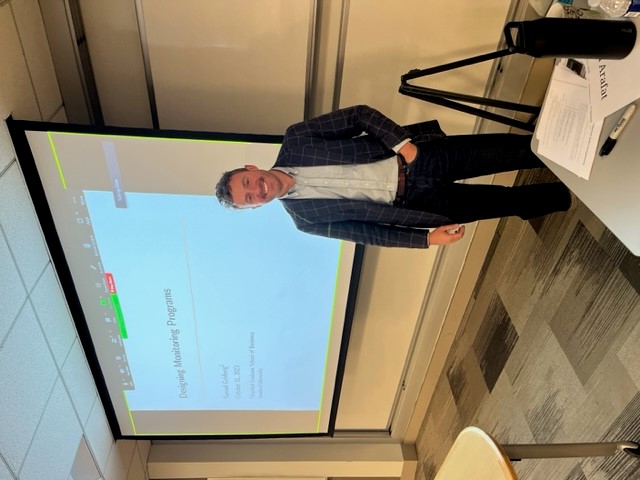|
Date
|
Speaker
|
Topic
|
Faculty Host
|
4/19/2024
Melcher Hall 365A
1:30 PM - 3:00 PM
|
Peggy Liu
University of Pittsburgh
|
Choosing Larger Food Portion Sizes for Others
-
Click to read Abstract
Consumers often choose portion sizes of food for others—including romantic partners, friends, and children. Across eight studies, the authors show that consumers choose larger portion sizes for others, compared to the portion sizes that consumers choose for themselves, the portion sizes that consumers predict others want to eat, and the portion sizes that others want to receive. Moreover, the authors show that one reason consumers choose larger portion sizes for others is because consumers aim to convey warmth via larger portion sizes. The tendency to choose larger portion sizes for others is mitigated when consumers focus on addressing alternative concerns besides conveying warmth, such as when addressing fairness concerns (e.g., wanting to ensure enough food for multiple others) or when addressing health concerns for others (e.g., choosing portion sizes of unhealthy food for dieting adults or for one's young children). Ironically, however, choosing larger portion sizes for others (vs. for self) does not actually convey greater warmth to recipients. Thus, the authors suggest that consumers' tendency to choose larger portion sizes for others may mainly have negative consumer and societal well-being implications, to the extent that receiving larger portion sizes might lead to overeating and/or food waste.
|
Byung
|
4/6/2024
CBB (Room 310)
8:15 AM - 4:30 PM
|
Doctoral Students
|
The 42nd Annual UH Marketing Doctoral Symposium
|
|
4/5/2024
Melcher Hall 365A
11:00 AM - 12:30 PM
|
Ravi Mehta
University of Illinois - Urbana Champaign
|
Fostering Innovation Through Consumer Engagement: The Role of Luxury Brand Usage Experience
-
Click to read Abstract
Prior work has revealed negative demand-side implications of engaging consumers for their innovative inputs (e.g., user-generated designs) by luxury brands. Extending this line of work, we examine the supply-side (e.g., idea generation) implications of consumer engagement through the lens of luxury brand usage experience. Across five studies, we demonstrate that consumers who engage in luxury, as compared to non-luxury, brand experience through product usage generate more innovative ideas. This effect stems from feelings of vertical differentiation that arise from using a luxury brand. Explicating the boundary conditions of the effect, we also demonstrate that such a positive effect of luxury brand usage experience on consumer innovativeness does not emerge when 1) individuals are merely exposed to a luxury brand (i.e., engaging with it is a necessary condition), and 2) when the luxury brand usage fails to convey the signals of prestige and exclusivity central to feelings of vertical differentiation. The current research offers theoretical and managerial implications for luxury brand and innovation management.
|
Sesh
|
4/5/2024
CBB (Student Training Center)
3:45 PM - 6:00 PM
|
John G. Lynch, Jr.
University of Colorado-Boulder
|
The 42nd Annual UH Marketing Doctoral Symposium
|
|
3/29/2024
Melcher Hall 365A
11:00 AM - 12:30 PM
|
Huanhuan Shi
Texas A&M
|
The Economic Consequences of Risk-Absorption in B2B Relationships: Evidence from Indirect Auto Lending
-
Click to read Abstract
Risk absorption is ubiquitous in inter-firm relationships. For example, manufacturers may cover small suppliers' production cost risks, and suppliers might take on some buyers' payment default risks. This risk absorption aims to enhance value and
foster long-term partnerships. Despite recognizing this intention, there is limited research on the economic consequences for the risk-taker. The authors examine the costs and benefits of risk absorption in indirect car loan markets, where third-party
lenders rely on auto dealers to reach consumers. In this scenario, risk absorption happens when third-party lenders approve loans for high-risk consumers, allowing auto dealers to complete transactions, even for consumers who typically would not
qualify for loans. Using a comprehensive dataset spanning three years from a third-party lender working with 1,550 dealers, the authors explore (1) the actual costs related to risk absorption, such as loan defaults and overdue payments, (2) how dealers reciprocate and benefit by assessing how lender risk absorption affects dealer referrals in terms of loan amounts (gains) and loan risk (losses), and (3) heterogeneity in how dealers respond to risk absorption. While lenders incur direct costs for offering favorable loans, dealers reciprocate by generating more loan applications in the future. However, the risk associated with referred loans also increases, possibly due to perceived leniency by the lender being exploited. Additionally, we find that as the relationship between a lender and a dealer extends, the reciprocal effects initially strengthen and then decline, while the direct cost and exploitation effect increases monotonically. These findings provide insights into lenders’ effectiveness in absorbing risks and strategies for managing relationships with dealers.
|
Johannes
|
3/22/2024
Melcher Hall 365A
11:00 AM - 12:30 PM
|
James Reeder
University of Kansas
|
Using Contextual Embeddings to Predict the Effectiveness of Novel Heterogeneous Treatments
-
Click to read Abstract
Our study demonstrates the power of using contextual embeddings to evaluate new marketing creatives. To explore the usefulness of contextual embeddings, we exploit an advantageous setting where 34 emails were sent to 1.3 million clients over a 45-day period. To create our contextual embeddings, we use OpenAI to translate email subject lines into Ada embeddings, a class of contextual embeddings. We find that Ada embeddings outperform other commonly used, text classification methods. Further, through a series of leave-one-out exercises, over 85% of our candidate emails have accurate predictions between our contextual embeddings model and the doubly robust scores obtained from market campaigns. Given that OpenAI generated our contextual embeddings, we link our method with ChatGPT to evaluate newly generated email creatives. ChatGPT is given a set of email features that show common support within our observed dataset. We find that while ChatGPT is able to generate novel email promotions quickly, it is unable to accurately predict the success of the new emails. We then conclude by using a data-driven algorithm to conduct a heuristic-driven targeting exercise using both the GPT developed emails and client characteristics. Our study shows the viability of contextual embeddings in academic research and in assessing the development of novel heterogeneous treatments.
|
Martin
|
2/16/2024
Melcher Hall 365A
11:00 AM - 12:30 PM
|
Vamsi Kanuri
University of Notre Dame
|
Mitigating Churn After Financial Fraud: The Value of Blame Attribution During Service Recovery
-
Click to read Abstract
The financial industry is plagued with account-based fraudulent transactions in which perpetrators surreptitiously siphon away money from customer accounts. To address this recurrent problem, service operations teams at financial institutions (e.g., the fraud detection and mitigation teams) spend millions yearly identifying perpetrators, attributing blame, and averting customer churn. However, in most cases, the service operations teams cannot trace fraudulent transactions back to the perpetrators. Hence, it remains unclear whether they should continue to expend significant resources into investigating account-based fraud and attributing blame. Employing a wide range of econometric and machine learning techniques on a rich dataset from a U.S. bank, we attempt to offer the first empirical assessment of the association between blame attribution, or lack of it, in response to account-based fraud and customer churn. The results indicate that relative to the customers who did not experience fraud, those who did and received a resolution lacking blame attribution are 40.69% (95% CI = [24.41%, 56.97%]) more likely to churn permanently. However, customers who experienced fraud and received a resolution involving blame attribution are 62.45% (95% CI = [31.22%, 93.68%]) less likely to churn than those who did not experience fraud. The latter result offers the first field evidence of the service recovery paradox. Additionally, we observe significant heterogeneity in the findings based on customer tenure and the number of customer-firm interactions and document the long-term effects of attributing and not attributing blame. These insights can assist service operations teams in their post-recovery efforts to mend customer-firm relationships following a service failure. Overall, the results underscore the importance of blame attribution during service recovery for service operations teams and inform a topical debate on a banking reform proposed by the U.S. Department of Treasury.
|
Martin
|
12/1/2023
Melcher Hall 365A
11:00 AM - 12:30 PM
|
Kristin Donnelly
University of Chicago
|
The End is in Sight: Framing Periods by Duration Makes Them Feel Longer
-
Click to read Abstract
Time periods are frequently described by either duration or endpoint. Extant relevant research only involves periods that span weeks, months or years (LeBoeuf et al., 2006 Read et al., 2005), yet many of consumers' routine experiences involve shorter time horizons. For example, assuming a current time of 6pm, you might learn that your table will be ready “at 6:30”, or “in 30 minutes”. Do these descriptions feel the same? Across thirteen pre-registered experiments, we find that time periods are perceived as longer when described by their duration (e.g. 45 mins, assuming a current time of 2:00pm) rather than their endpoint (e.g. 2:45pm). Reflecting this, participants anticipated being able to complete more things during a period when it was described by duration (compared to endpoint). Moreover, we demonstrate that describing waiting periods by duration reduces participants' willingness to wait and increases their willingness to pay to reduce the wait.
|
Byung
|

|
11/17/2023
Melcher Hall 365A
11:00 AM - 12:30 PM
|
Ilya Morozov
Northwestern University
|
Where Does Advertising Content Lead You? We Created a Bookstore to Find Out
-
Click to read Abstract
We study how advertising content influences consumers' decisions. To this end, we create a simulated online bookstore that imitates a real online shopping experience. We then conduct a pre-registered and incentive-compatible experiment in which we randomly expose store visitors to display ads, randomizing both advertising exposures and content. We find that ad content plays a major role in shaping advertising effects. Ads that reveal the book's attributes generate substantial effects on search and choice, over and above the impact of ads that do not reveal these attributes. Ads that call attention to a book's low price reveal that the book is less expensive than consumers thought, universally increasing demand for the advertised book. By contrast, ads that highlight the book's genre induce some consumers to search and buy the book but lead others to reject this option without search. These polarized responses may increase or decrease the total number of searches and purchases of the advertised book depending on the share of consumers who favor the revealed genre. Overall, our findings suggest that advertisers should carefully choose which product attributes to reveal in their ad copies.
|
Sesh Tirunillai
|

|
11/3/2023
Melcher Hall 365A
11:00 AM - 12:30 PM
|
Sam Goldberg
Stanford University
|
Designing Monitoring Programs
-
Click to read Abstract
I study the design of voluntary consumer monitoring programs in auto-insurance, using data from more than 2 million unique drivers. Monitoring technology tracks driving behaviors and provides performance incentives for improved driving, in the form of discounts on future premiums. The efficacy of these programs depends on who chooses to participate and their ability to influence driver risk. Because drivers anticipate performance incentives when making their participation decision, these goals are fundamentally tied. I estimate a model with both selection and moral hazard using unique variation in both performance and participation discounts. Through the lens of the model, I non-parametrically recover the joint distribution of drivers risk characteristics. I use my model to perform two counterfactuals of interest. First, I
separate the screening and risk adjustment effects and estimate the welfare of monitoring programs in this setting. Second, I use my model to examine counterfactual incentive schemes that illustrate how different incentive structures screen different drivers in and out of the program.
|
Bowen
|

|